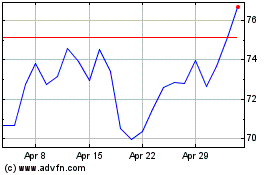By Cassandra Sweet
A federally backed, $2.2 billion solar project in the California
desert isn't producing the electricity it is contractually required
to deliver to PG&E Corp., which says the solar plant may be
forced to shut down if it doesn't receive a break Thursday from
state regulators.
The Ivanpah Solar Electric Generating System, owned by
BrightSource Energy Inc., NRG Energy Inc. and Alphabet Inc.'s
Google, uses more than 170,000 mirrors mounted to the ground to
reflect sunlight to 450-foot-high towers topped by boilers that
heat up to create steam, which in turn is used to generate
electricity.
But the unconventional solar-thermal project, financed with $1.5
billion in federal loans, has riled environmentalists by killing
thousands of birds, many of which are burned to death--and has so
far failed to produce the expected power.
PG&E is asking the California Public Utilities Commission
for permission to overlook the shortfall and give Ivanpah another
year to sort out its problems, warning that allowing its power
contracts to default could force the facility to shut down. The
commission's staff is recommending that it grant the extension
Thursday.
"Continuing the delivery of [renewable] energy from these
innovative energy facilities is in the interest of all parties and
furthers important state and federal policy goals," a PG&E
spokeswoman said.
Spokesmen for BrightSource, which developed the technology, and
NRG, which operates the plant, declined to comment on its future.
NRG has said it has taken more than a year to adjust equipment and
learn how to best run it.
The Energy Department said last week it supports giving the
plant, which started operating in early 2014, more time.
However, the extension request is opposed by some consumer
groups, who are complaining that the cost of the electricity from
the struggling plant is exorbitant.
Power from the two Ivanpah units that serve PG&E last year
fetched about $200 a megawatt-hour on average during summer months,
and about $135 a megawatt-hour on average the rest of the year,
according to sales data from the Federal Energy Regulatory
Commission.
That compares to an average price of $57 a megawatt-hour for
solar power sold under contracts signed in 2015, according to
Bloomberg New Energy Finance. Power from natural-gas plants went
for $35 a megawatt-hour on average in California's wholesale market
last year, according to a Wall Street Journal analysis of data
compiled by the Energy Department.
PG&E negotiated the contracts in 2009, when solar power
prices were much higher.
"We think PG&E could negotiate a better price," said Karin
Hieta of California's Office of Ratepayer Advocates, which believes
PG&E should cancel the contract or rework the deal.
The portion of the Ivanpah plant that supplies PG&E in 2014
generated 45% of the electricity the state commission expected
under the power contracts, and 68% in 2015, according to a Wall
Street Journal analysis of federal data and state documents.
The plant wasn't required to meet the full amount, under the
confidential terms of the contracts, said Joe Desmond, a senior
vice president at Oakland, Calif.-based BrightSource.
PG&E signed the Ivanpah contracts as part of efforts to
comply with a state law that requires utilities to provide 33% of
their power from solar, wind or other renewable sources by 2020.
State lawmakers last year boosted the mandate to 50% renewables by
2030. A spokesman said PG&E has more renewable energy than it
needs to meet its current requirement, and it is still on track to
meet both mandates.
Helping Hand Tools, an environmental group that fights
construction of new power plants, is also asking the state
commission to reject PG&E's request to give the Ivanpah plant
more time. Unlike traditional solar projects, Ivanpah uses natural
gas to heat boilers to make steam used to warm up its power
turbines, which emits some pollution.
"It's not a renewable energy plant, it's part gas, part solar,"
said Robert Sarvey, a spokesman for the group.
More than 2,000 wild birds died at the Ivanpah plant between
March and August of 2015, according to estimates that biologists
hired by the plant owners filed this week and in December with the
state Energy Commission.
Roughly half of the dead birds the biologists found had feathers
that were singed or burned, most likely from flying through an area
of intense heat between the mirrors and the power towers, according
to the reports.
To be sure, birds also fall prey to other renewable-energy
projects: Wind turbines kill between 140,000 and 328,000 birds in
the U.S. every year, according to a 2013 study by researchers at
the Smithsonian Conservation Biology Institute.
(END) Dow Jones Newswires
March 16, 2016 19:42 ET (23:42 GMT)
Copyright (c) 2016 Dow Jones & Company, Inc.
NRG Energy (NYSE:NRG)
Historical Stock Chart
From Mar 2024 to Apr 2024

NRG Energy (NYSE:NRG)
Historical Stock Chart
From Apr 2023 to Apr 2024
